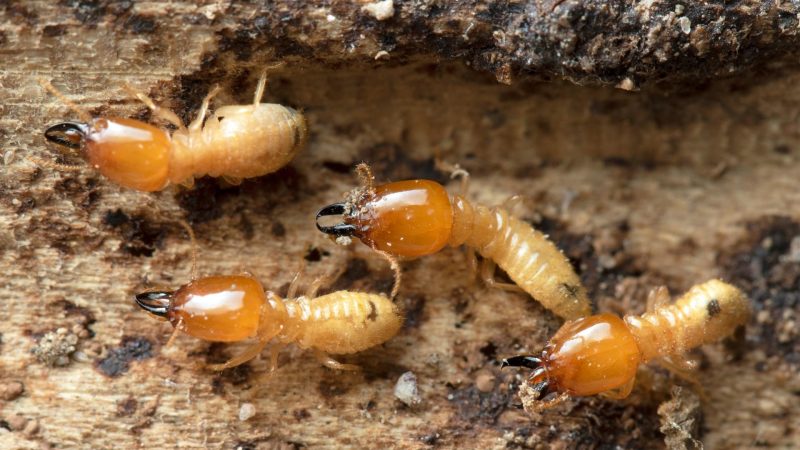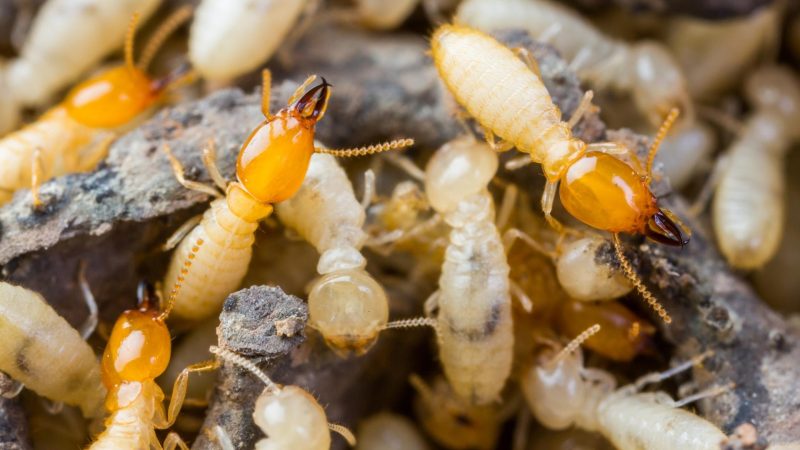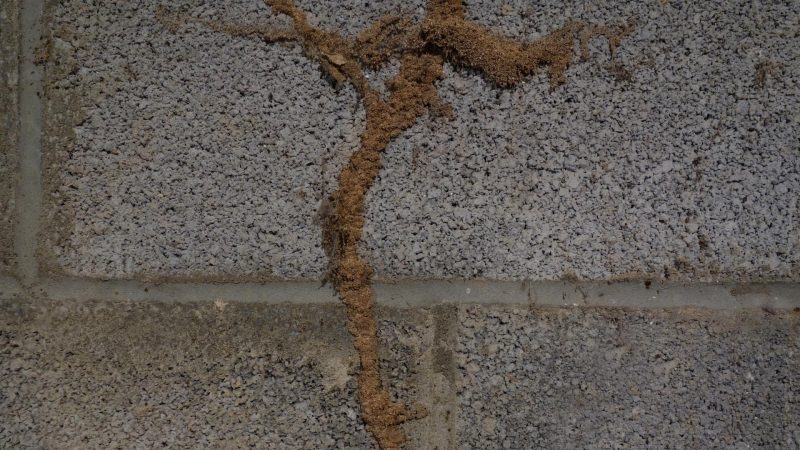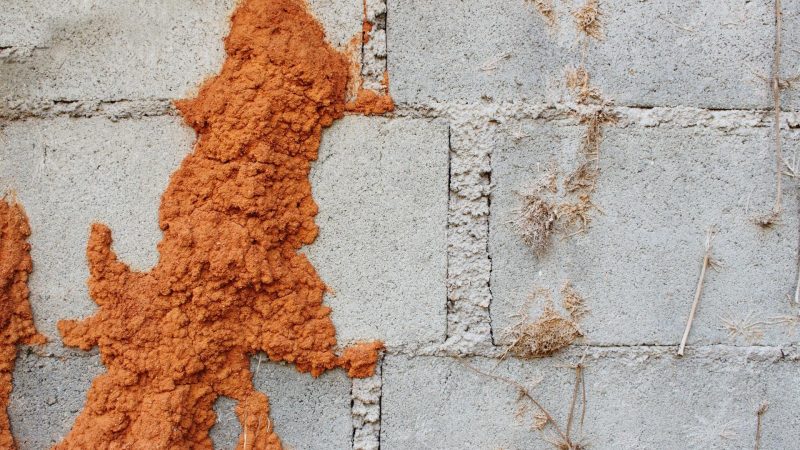Having termites on your wall is a very serious problem. Termites are very small, and they can easily hide inside your walls without your knowledge.
Once ignored, they will quickly spread out in different parts of your house. A severe termite infestation can damage your entire house, and repairs can cost a lot of money.
So, what are the early signs of termites in drywall? Among them are hollow and headbanging sounds when you tap the wall, the presence of tiny holes, paint peeling off, sunken trails of mud tubes, and cracks and termite wings on the baseboard. In some cases, windows and doors become hard to close and open.
Unfortunately, termites damage drywall without seeing them doing it. These wood-eating insects attack gradually, and most of the time, they cause severe damage before you can take action.
In this guide, you will not only know the early signs of a termite infestation, but you will also learn how to deal with them.
What are the Three Main Types of Termites?

There are more than 2,600 termite species around the world, and they can be categorized into three types – dampwood termites, subterranean termites, and drywood termites.
Each of them has a different physical appearance, habitat, and feeding behavior. However, all of them feed on wood and can infest your house.
Dampwood termites have high moisture requirements and usually infest decayed wood. They are rarely in houses and buildings because wooden structures are low in moisture.
Subterranean termites usually live in the ground and infest dead wood, fallen trees, and wooden foundation that is in contact with the soil.
On the other hand, drywood termites don’t need soil moisture to survive. They are mostly found in stored lumber, wooden fences, walls, and furniture.
A drywood termite colony may only have about a thousand individuals, while a colony of subterranean termites can consist of hundreds of thousands of them.
Related: How to Get Rid of Subterranean Termites? | Control and Prevention
What Kind of Termites Eats Your House?

Generally speaking, there are three main castes of termites – workers, soldiers, and reproductive termites, which are the king and queen and are also called alates.
Both the worker and soldier termites don’t have eyes and are blind, but drywood termite workers are very likely the ones that will eat your house slowly.
How Do You Know If You Have Termites Eating Your House?

It usually takes several years for a termite colony to grow, and termites are so small and not usually exposed. This is why not seeing one in your house does not necessarily mean that there is no infestation.
But fortunately, there are visual signs or clues of their presence. Here are some of the most obvious ones:
1. Mud Tubes
Mud tubes are narrow tunnels that termites use to go back and forth from their colony to houses. Worker termites built these tunnels to bring food (wood) to their king and queen.
These earth-hardened mud tubes are made of termite saliva, soil, wood particles, or drywood and are sure signs that there are termites.
These mud shelter tubes can be seen under the eaves, on the exterior and interior walls, floor joists, foundation walls, plumbing under the house, or hanging on the ceiling.
Once you break these tubes, you are very likely to see worker and soldier termites. Unfortunately, it’s quite hard to tell when these mud tubes were built.
2. Termite Swarmers
Termite swarmers are the reproductive termites that emerge in almost all seasons of the year, except during winter. These winged termites can be seen flying from mud tubes during the day, usually after the rain. Their presence inside your home strongly suggests that termites are already eating your house slowly.
Note, however, that winged termites can be mistaken for flying ants. But if you take a closer look, you will notice that termites have straight and beadlike antennae while ants have bent antennae. Termite swarmers also have equal lengths of wings, while the front wings of ants are longer than their hind wings.
3. Discarded Termite Wings
Aside from the swarmers, you may also see some termite wings on your floor and window sill. These alates or reproductive termites enter homes in search of mating partners and a suitable place where they can start a new colony.
Once they find an ideal partner, these swarmers will automatically lose their wings.
Fortunately, these winged termites don’t cause damage and rarely eat wood. The only purpose of these new sets of king and queen termites is to start a colony. To do this, they have to dig underground and create a nest.
However, getting rid of swarmers does not necessarily mean there are no more termites in your home.
4. Termite Droppings
Also called frass, termite droppings are about 1-2 mm long, light brown, tan, or almost black. Termites push these dry pellets out through small “kick-out holes.”
These tiny pellets are oval, with six sides, and look like sawdust or coffee grounds. If you roll them between your fingers, you will feel their gritty texture.
But contrary to popular claims, the color of a termite’s poop is not related to the color of the wood that it has eaten.
Nonetheless, a study about drywood termites suggested that the sizes of these termite feces can provide information about the nutritional value of the wood that they last ate and the species they belong to.
How to Tell if You Have Termites in Your Walls?

As mentioned above, drywood termites may enter your house hide inside your wooden walls, and eat them. Therefore, getting rid of these termites can be very challenging. In severe cases, the process is very expensive.
So, to help you out, here are some early signs of termites in the drywall that you should observe:
1. The Wall Has Tiny Pinholes
If you spot some mud tubes on your drywall, check if there are some tiny holes underneath them. These so-called pinholes were accidentally made by termites and you may see some workers getting out of them. In most cases, termites will try to repair these pinholes with mud so that they can avoid the outside airflow.
2. Hollow Sound Within the Wall
Tap the drywall and listen carefully. If there is a hollow sound within the wall, likely, there are already lots of termites inside. The empty sound strongly suggests that termites have already eaten or are still eating your wall. The same scenario may also be present if the wood is crumbling once you touch it lightly.
3. Headbanging Sounds
Termites in walls create so-called headbanging sounds, which are the loudest sounds that they can produce. Once termites are disturbed or threatened, they bang their heads on the drywall to warn the colony of possible danger. Strangely, termites cannot hear these sounds, and they only rely on the vibrations they feel.
4. Wall Has Bubbles
If your drywall is slowly having bubbles or a blistered appearance, it is very likely that the mud tubes inside are too close to the surface. It also suggests that termites inside are occupying lots of space within the walls. This will result in excess moisture within the wall, and the drywall will expand in some portions.
5. The Wall Paint Is Peeling Off
Aside from having bubbles, wall paint can peel off if there is a huge presence of termites inside the wall. This is also the effect of overcrowding of termites in the mud tubes. However, excess moisture in drywall can also be due to other factors such as water leaks or spillage. Both scenarios should be further investigated.
6. Sunken Trails Under the Paint
Termites don’t feed on the drywood itself but rather on the cellulose, which is the major component of wood. They eat the outer covering of the dry wood, but usually without destroying the paint. Because of this, termites leave trails of their path and mud tubes under the wall, causing some sunken areas under the paint.
7. Cracks and Termite Wings on the Baseboard
The baseboard is the lowest part of an interior wall and is mostly made of wood. If baseboards have cracks, subterranean termites are likely to have entered the wall. Unlike drywood termites, they usually start eating walls from the bottom. Meanwhile, termite wings on baseboards also mean that swarmers are present.
8. Tight Doors and Windows
There are several possible reasons why your doors and windows are now tight or difficult to close and open. This includes damaged frames, shifting foundations, wood becoming warped due to excess moisture or old age, and the build-up of dirt or dust inside. On the other hand, another cause for obstruction is termite infestation.
How to Get Rid of Termites in Walls?
Controlling termites inside houses is a very challenging task. To start with, most control methods may require special skills in identifying which type of termites are invading the house. But at an early stage of termite damage in drywall, here are some things you can do by yourself:
- If possible, remove infested wood or structure from your house.
- A 2020 study suggested that 36% to 44% of Western drywood termites died after conducting heat treatment at 134-146°F (56.6-63.3°C) for about 140 minutes.
- The same study added that spraying wintergreen essential oil directly on termites had a mortality rate increased to between 92% and 100%.
- A separate study suggested that applying dry Diatomaceous Earth (DE) directly to subterranean termites for 6 hours leads to a 100% mortality rate.
- If you will use pesticides, choose those with Fipronil, such as Termidor Foam Termiticide .
- Alternatively, you can also use Harris Carpenter Ant Killer & Termite Control Treatment . This product is odorless and EPA-registered for indoor and outdoor use.
While all of the above tips work well in getting rid of a termite nest on a wall, most of them should be done repeatedly. Results also vary, depending on the severity of the termite infestation. In severe cases, DIY (Do-it-yourself) treatments are not effective enough and repeated fumigation by pest professionals is needed.
List of Sources
Waldvogel, M., Alder, P. (2017). Termites – Biology and Control. NC State Extension.
Layton, B. Signs of Termite Infestation. Mississippi State University Extension.
Peck, A. (2017). Flying Ants And Termites. Agriculture and Natural Resources, University of California.
Lewis, V. R., Sutherland, A. M., Haverty, M. I. (2014). Subterranean and Other Termites. University of California Agriculture & Natural Resources.
- Bed Bug Surge 2025: How to Detect, Prevent, and Safely Eliminate Infestations in Top U.S. Cities - June 18, 2025
- Asian Needle Ants Invade US Homes: 2025 Guide to Identification, Risks, and Effective Control - June 11, 2025
- New World Screwworm Alert: How US Livestock Owners Can Prevent Outbreaks and Protect Herds [Summer 2025 Update] - June 8, 2025
